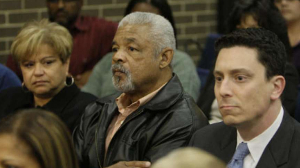Tolan v. Cotton ⸻ Story │ Record │ Discussion
► This Case Study — besides involving a controversial high-profileα (serious but non-lethal) race-related police shooting incident (“Driving While Black;” the phrase has even been used in federal appellate decisions) on New Year’s Eve, Dec 31 2008 — is unusual here for the reason that it (eventually) had a “(limited) happy ending,” in the (limited) sense that the Supreme Court ultimately “did the (limited) right thing.”β The case we review is a Federal civil case (following an earlier (local) criminal case, which we short-shrift), at Summary Judgment, and the interesting Judicial Misconduct happened, not at the Supreme Court, but at the lower District/Appellate levels.
α・ Wikipedia; New York Times ⌥; CNN YouTube ⌥; Houston Chron ⌥; Washington Post ⌥; The Atlantic ⌥; USA Today ⌥; American Bar Association ⌥; Houston Press ⌥; Greg Gumbel, Black In Bellaire ⌥. Had this case involved a fatal shooting, it would have been (no doubt) much more famous/notorious than it was, as it immediately presaged the “Black Lives Matter” movement, instigated by the shootings/killings of Trayvon Martin (by George Zimmerman, in Sanford, Florida, Feb 26 2012), Eric (“I can’t breathe”) Garner (New York City, July 17 2014), Michael Brown (Ferguson, Missouri, Aug 9 2014), Tamir Rice (Cleveland, Nov 22 2014), Walter Scott (North Charleston, South Carolina, Apr 4 2015), Laquan McDonald (Chicago, Oct 20 2014), Freddie Gray (Baltimore, Apr 12 2015), Philandro Castile (Falcon Heights, Minnesota, Jul 6 2016); Mother Jones ⌥; New York Times ⌥; The Atlantic ⌥ (noting the false/fake-excuse of “reaching for gun in waist-band” by police here); Washington Post ⌥; Los Angeles Times ⌥ (another infamous “waist-band” absurdity/insanity, this one involving a white victim); etc., ad infinitum, ad nauseum …
β・ Because of the larger context of the case’s situation (civil rights, racial discrimination, police profiling/misconduct/brutality), Tolan v. Cotton cannot necessarily be said to have had a “(fully satisfying) happy ending,” in the overall sense of all-around substantive justice. However, this Judicial Misconduct forum is not an appropriate place to comment further upon that. We cite to the widespread press coverage for the “bigger story” (ƒα supra), and restrict ourselves in this place to focus only on the Judicial Misconduct aspects of the case.
For much more information on the human-interest aspects (as opposed to the strictly legal aspects) of this story, see Tolan’s book, No Justice: One White Police Officer, One Black Family, and How One Bullet Ripped Us Apart (https://www.amazon.com/No-Justice-Police-Officer-Family/dp/1478976659). See also Tolan’s (incipient) website, https://robbiertolan.wixsite.com/robbietolan2. ◄


Background
Robert R. (“Rob,” “Robbie”) Tolan ⌥ was, in 2008, a “fine upstanding young man,” 23 years old, an only-child, living at home with his parents, Robert T. (“Bob,” “Bobby”) and Marian Tolan, all long-term residents (> 15 years) at the same house (804 Woodstock St., on a cul-de-sac/dead-end) in Bellaire, Texas (an affluent, predominantly white suburb, only 1% black, on the near southwest side of, and partially surrounded by, Houston, in Harris County, Texas). Robbie aspired to continue his dream career of professional baseball,γ most recently playing for the Bay Area Toros (based in Texas City, along Galveston Bay, 37 miles southeast of Houston) of the short-lived Continental Baseball League; he also worked as a restaurant waiter during the off-season.
γ・ Robbie’s father, Bobby, had also been a (well-known, major league) professional baseball player, and later coach and manager (Topps, Bobby Tolan ⌥).
Underlying Facts: Shooting Incident
► The facts related here are taken from various places in the record (Complaint ⌥; Motion/Memo for Summary Judgment; Opposition to Summary Judgment; District Court Decision ⌥, Tolan v. Cotton, 854 F.Supp.2d, 444 (2012) ⌥; Appellate Decision ⌥, 713 F.3d 299–309 (5th Cir. 2013) ⌥; Supreme Court Decision ⌥; and elsewhere), all disputes/discrepancies being resolved in favor of the Plaintiffs (as required, by Summary Judgment rule). ◄


In the early morning (~1:50 a.m.) of New Year’s Eve, Dec 31 2008, Robbie Tolan and his best friend (and first cousin, actually more like a brother) Anthony Cooper, both black men, having spent the evening out (dinner, pool/billiards with friends) and now driving home (in a black 2004 Nissan Xterra SUV, belonging to and driven by Robbie), picked up some take-out burgers-and-fries at a fast-food restaurant (Jack-In-The-Box) before continuing on their way home (Anthony also lived at 804 Woodstock St.). They arrived and parked on the street in front of the house, as always. The friends/cousins were not under the influence of alcohol or drugs, carried no weapons, and exhibited no suspicious/illegal/threatening behavior.
As they exited the car (and locked it), and proceeded up the walk to the front door of the house, they were accosted by Bellaire Police Officer John Edwards, who had apparently followed them for some reason (really, for “driving while black”). Edwards, gun drawn (hence immediately/unnecessarily escalating the incident), ordered Robbie and Anthony to get on the ground, just as Bellaire Police Sergeant Jeffrey Cotton also arrived on the scene, ~90 seconds after Edwards (both policemen were white), also drawing his gun. When Robbie asked why they were being ordered to the ground, Edwards replied the Nissan had been reported stolen (noting, parenthetically, that (i) only the car license plate may have been stolen (and placed on a different car), that (ii) car theft is not usually a violent crime, and (iii) the people in the car were not necessarily the thieves (they my have borrowed the car from the presumptive thief, long after the presumptive theft), so (iv) Edwards had no reason to cover the “suspects” with his gun drawn). Of course, it had NOT been stolen. It later transpired that Ofc. Edwards had (inadvertently?) entered an incorrect/wrong license plate number into his police computer (“Mobile Data Terminal”) — 695BGK, instead of the correct 696BGK (noting that normal procedure is to “run the plates twice,” to avoid just such an error, but Edwards failed to do that) — resulting in a “hit” on a different car, also a black Nissan, but differing from Robbie’s car in model-year, and having very different/wrong model/type/classification/form-factor (Altima mid-size, not Xterra SUV) — things that municipal police officers are habitually trained to notice (traffic violations and auto getaway reports being their bread-and-butter).
Bobby and Marian Tolan (parents/uncle/aunt of the friends/cousins), hearing Robbie unlocking their front door with his key, and hearing the commotion, exited their front door (street-side, in plain view of the others present) a few seconds later, in their pajamas(!), to investigate. They (Bobby and Marian) announced that they would “handle the situation,” speaking for the friends/cousins thereafter. They both (and the cousins, too) told the policemen that there must be a mistake/misunderstanding, because the house was theirs, the whole family (Bobby, Marian, Robbie, Anthony) lived at that address, and the car in question was Robbie’s. THAT SHOULD HAVE IMMEDIATELY ENDED THE INCIDENT RIGHT THERE — the report by the elder Tolans being entirely credible, even to an unbiased bystander much less a trained/experienced police officer, a quick/trivial re-check of the “stolen car” report would have sufficed to clear the matter up — “BUT FOR” THE “SUSPECTS” BEING “‘BLACK’ IN THE EYES OF THE POLICE.” Despite that plain/convincing clarification/confirmation from obviously law-abiding citizens, the policemen continued to order Robbie and Anthony to lay down on the ground, and Bobby to spread-eagle against his own car (a Chevrolet Suburban, though in one report called a Ford Explorer) in the driveway; all complied (Robbie face-down on the porch, Anthony face-up in the yard); nobody resisted/challenged/evaded police authority. Yet Cotton still escalated again, ordering Marian to “get against the wall,” and when she repeated “this is a big mistake,” he “manhandled” her, grabbing her by the arm and shoving/slamming her against the garage door, painfully/injuriously, with unnecessarily/unreasonably excessive force, knocking her to the ground.
Witnessing that assault/attack (especially the loud sound of Marian being thrown against the metal garage door), Robbie reflexively verbally protested to Cotton, “Get your fucking hands off my Mom.” In so doing, Robbie (who had been lying face-down, pointed away from Marian, with his arms pointed forward, away from his body) pulled his arms back to raise/turn/twist his torso (in a kind-of push-up maneuver), to (one or both) knees, so he could observe/address the situation; but he did not stand up, or approach Cotton (remaining 15–20 feet from him), or give any indication of physical threat/aggressiveness (such as brandishing or reaching for a (nonexistent) weapon). Nevertheless, Cotton (who would later testify he thought he “perceived” Robbie moving his hand past his waistband area “as if” reaching for a weapon), saying nothing (no verbal warning), got “trigger-happy” and immediately shot at Robbie (unnecessarily, since Ofc. Edwards was also “covering” Robbie, gun pointed directly at him, “had Sgt. Cotton’s back,” but saw no need to shoot) three times with his .45-caliber service revolver, hitting him once, wounding him severely (life-alteringly, but non-fatally). The bullet entered Robbie’s body just below his right nipple, cracking ribs, piercing/collapsing his right lung, and lodging in his liver (a trajectory perfectly consistent with Cotton being in an upright stance, and Robbie being on the ground in a kneeling position); incidentally ending his baseball career. At that point, Cotton had been on-scene for only 32 seconds (consistent with “panicking”). Cotton sought, but did not find, a weapon (hence making the shooting unjustified). The policemen called for an ambulance, but they prevented anyone at the scene from aiding the wounded man, or accompanying him to the hospital. Elements of a cover-up by the Bellaire Police Department appeared to ensue; in particular, witnesses (more had appeared in the interim) heard Cotton tell other policemen they “needed to get their story straight,” and observed/reported officers typing various combinations of license-plate numbers/letters into a police computer, seeking one that would “nearly-match” the Nissan’s (both in license-plate, and in make/model/color of car).
The entire incident at the Tolans’ house lasted ~10 min. A police dash-cam video recording is said to exist, but this reviewer has not succeeded in locating it its entirety (but see CNN YouTube ⌥). This Is Criminal (PRX, Public Radio Texas) ⌥.
Criminal Case Against Cotton

On Apr 6 2009, on the initiative of the Harris County District Attorney, Sgt. Cotton was indicted by a Harris County grand jury, charged with the first degree felony of Aggregated Assault by a Public Servant. Houston Public Media ⌥; Scheiner Law ⌥; New York Times ⌥.
On May 3–11 2010, the trial took place in the Harris County 232nd District Court. The judge was Mary Lou Keel; the jury consisted of 3 men and 9 women, only 2 of whom (women) were black. Bellaire Instant News ⌥; ABC 13 Houston ⌥; Houston Chron ⌥.
On May 11 2010, the jury returned a Not Guilty verdict, acquitting Cotton, finding that the shooting was “justified,” in “self-defense.” Houston Chron ⌥; ABC 13 Houston ⌥; New York Times ⌥. (Perhaps unsurprisingly, cynically, Cotton was later promoted to Lieutenant.)
No suggestion has ever been made that any Judicial Misconduct was committed during the criminal trial. On the other hand, “jury misconduct” might be a reasonable suspicion (though admittedly, such a conclusion cannot be drawn without full review of the trial transcript, and perhaps even presence in the courtroom itself, to weigh “intangibles,” such as “persuasive/convincing demeanor”).
But, concurrently with the criminal case, a corresponding civil case had already been initiated too, and that’s the main focus of this Case Study. We turn our attention to it now infra.
Civil Case
District Court: Dismissal At Summary Judgment

On May 1 2009, concurrent with the proceedings of the criminal case (supra), Federal Civil Action was filed in S.D.Tex. (Houston), Fifth Cir., on various Causes of Action, clustering around violation of the (Federal) Civil Rights (Equal Protection) and Excessive Force guarantees of the Fourth (“reasonableness”) and Fourteenth (“due process,” “equal protection”) Amendments, under 42 USC §1983 (which statute, however, doesn’t apply to Federal actors, or to judges(!)). District Court Docket; Complaint ⌥; Answer #1 to Complaint; Answer #2 to Complaint. For legal background on 42 USC §1983, see: Huffington Post ⌥; Federal Practice Manual ⌥. The case was assigned to Judge Melinda Harmon.
On Jan 1 2011, the Defendants filed a Motion for Summary Judgment, on the basis of “(qualified) immunity:” Motion/Memo for Summary Judgment. On Jan 24 2011, the Plaintiffs filed their Opposition to that motion: Opposition to Summary Judgment. A little more legal skirmishing followed: Reply to Opposition; Surreply; Response to Surreply. These filings well-illustrate an infamous/cynical lawyers’ aphorism: “When the facts are against you, argue the law (Defendants); when the law is against you, argue the facts (Plaintiffs)” (namely, in this case, the Defendants argue about the (I) legalities of “qualified immunity,” as if that somehow overrides the (II) factualities(/DGIMFs) of the case at Summary Judgment; noting that in this case we are sympathetic to the Plaintiffs, because the facts are, under the total context of all circumstances, more compelling/controlling than the immunity laws). As subsequent proceedings would prove infra, the following recitation of DGIMFs from the Surreply is especially pertinent (emphasis omitted) — recalling that the touchstone of Summary Judgment is the mere existence (without determination/decision of “who wins”) of at least one DGIMF (Disputed Genuine Issue of Material Fact):
The evidentiary record establishes the existence of genuine issues of material fact [DGIMFs]. … See, e.g., Ex. 3 at 149:20–23, 150:14–17; Ex. 4 at 64:16–65:11; Ex. 6 at 100:18–101:2; Ex. 7 at 77:17–78:25; Ex. 9 at 105:5–16, 128:17–18; contra, Ex. 1 at 60:7–62:12, 65:2–5, 67:3–5, 67:25–68:3; Ex. 2 at 127:13–17, 173:1–3; Ex. 4 at 66:1–4, 67:20–22; Ex. 5 at 53:18–56:10; Ex. 12 at ¶¶ 61, 65, 71, 75. See also Ex. 3 at 149:20–23; Ex. 6 at 110:9–14, 146:5–20; Ex. 9 at 105:5–16, 128:17–18; contra, Ex. 1 at 65:2–5, 67:25–68:3. See also Ex. 3 at 152:8–11, contra, Ex. 1 at 67:3–5; Ex. 2 at 127:13–17, 173:1–3; Ex. 12 at ¶¶ 61, 65, 67, 71, 75. See also Ex. 3 at 152:12–13; contra, Ex. 1 at 53:18–56:10; Ex. 12 at ¶¶ 65, 67.
On Mar 31 2012, the District Court handed down its Decision (corrected) — (falsely) granting Summary Judgment. District Court Decision ⌥; Tolan v. Cotton, 854 F.Supp.2d, 444 (2012) ⌥.
THIS DISTRICT JUDGE’S (FALSE) DECISION IS THE CRUX OF THE JUDICIAL MISCONDUCT IN TOLAN V. COTTON (followed later by two affirming Appellate Court (false) Decisions, infra). Namely, what Judge Harmon (joined later by her Appellate judges, infra, albeit using slightly different reasoning) falsely ruled was that there existed NO DGIMFsδ in this case. More specifically, Judge Harmon falsely ruled that, while (II) there may/did indeed exist some/certain “Disputed Genuine Issues of Fact,” none of them were “Material” to the Defendants’ asserted defense of (I) “Qualified Immunity.”
δ・ The most prominent DGIMFs (all of which a jury was entitled to believe/find credible, and should/must not be resolved by the judge at Summary Judgment time): (i) Was the driveway area, particularly the porch, “dimly lit,” or was it sufficiently well-lit (by combination of street lights, squad car spotlight, floodlight over the garage, a lantern in the yard, a porchlight, and officers’ flashlights)? (ii) Was Marian in an “agitated/screaming state” (or merely “upset/disbelieving,” as innocent people always are, and which police officers are trained to expect/handle)? (iii) Did Marian “tussle” with Cotton, or was she just “in an uncompreheding daze”? (iv) Did Robbie “threateningly yell/shout/scream” at Cotton? (v) Did Robbie “abruptly approach/move towards Cotton,” to “intervene” with Cotton’s handling of Marian (noting that both sworn testimony and blood-stain evidence showed Robbie had not moved)? (vi) Why wasn’t Robbie given a verbal warning to not move, which was feasible/typical police procedure? (vii) Did Robbie really “pose a significant immediate threat of death or serious injury” to anyone? (viii) Did Cotton really “fear for his own, or others’, lives” (the only justification for applying deadly force)? (ix) Why were “guns drawn from the get-go,” given that no provocation ever existed? (x) Why weren’t the facially innocent/law-abiding late-middle-aged homeowners (and testimony revealed that the officers did recognize/believe them to be the homeowners) in their pajamas for God’s sake (!), believed as to their representations that the car was not stolen, and that Robbie and Anthony lived with them — at least to the extent of requiring/forcing an immediate reassessment of the situation and re-checking of the “stolen” license plate?
Judge Harmon’s reasoning, “justifying” her false decision, was (as proven by the later Supreme Court reversal, infra) stupidly flawed (“obviously biased”) in favor of the Defendant law-enforcement officials. Albeit, she cleverly tried to shroud her false reasoning in “muddled/baffling bullshit/doubletalk” (so it would “seem” “judicially reasoned” to the uninitiated, i.e., to laypersons, or less-than-exemplary lawyers), in the following manner, where she pseudo-“explains” in her published opinion, which, though strictly-speaking can be interpreted as valid (“jumping through her asshole, with a large grain of salt”), requires a rather non-trivial analysis (provided in a paraphrase at the end, here) to do so (internal cites omitted):
The usual summary judgment burden of proof is altered in the case of a qualified immunity defense. Although qualified immunity is called an affirmative defense, the defendant asserting qualified immunity does not have the burden to establish it. Rather, it is the plaintiff whose burden it is to negate the assertion of qualified immunity, once it is raised. An official need only plead his good faith, which then shifts the burden to the plaintiff, who must rebut the defense by establishing that the official’s allegedly wrongful conduct violated clearly established law. The plaintiff, bearing the burden of negating the defense, cannot rest on conclusory allegations and assertions, but must demonstrate genuine issues of material fact regarding the reasonableness of the official's conduct. Sergeant Cotton and Officer Edwards have raised qualified immunity in their summary judgment, and "the burden of negating the defense lies with [Marian and Robbie Tolan], even on summary judgment." In other words the Plaintiffs must satisfy their burden by negating immunity by specifically identifying evidence that rebuts the Defendants' presumed entitlement to dismissal based upon qualified immunity. [Or, to paraphrase in plain(er) English, the special alteration/twist in a qualified immunity defense is that the Defendant is given the advantage of being “presumptively (though rebuttably) innocent,” in the following sense: At Summary Judgment, the movant is partially unburdened to the extent of merely pleading (as-if at Motion-to-Dismiss stage, instead of proffer proof/evidence, which is the usual requirement at Summary Judgment stage) qualified immunity; even though the nonmovant remains fully burdened with proffering the usual proof/evidence required at Summary Judgment. HOWEVER, this alteration/twist is STILL subject to the normal SJTOR criteria, particularly the non-existence of any DGIMF.]
In reality, Judge Harmon not only (i) silently skipped-over some Plaintiff-supporting DGIMF’s, but (ii) when she did address DGIMF’s, she consistently falsely usurped the jury’s prerogative of ultimate fact-finder, falsely anointing/appointing herself “judge/jury/executioner,” by falsely making “allocations/determinations of truth/falsity” rightfully reserved for the jury. These charges were ultimately called-out by the Supreme Court, infra; but first we must review the Appellate review of the case, immediately infra.
Appellate Court: Affirmation Of Dismissal




On May 2 2012, the Plaintiffs appealed. Appeals Court Docket. The Appellant’s Brief well-argued that (i) a rational/reasonable fact-finder could have easily found Cotton’s actions to be unreasonable, and that (ii) multiple key facts were disputed (DGIMF) which the (iii) District Judge did not resolve in favor of the Plaintiffs, hence (iv) a jury should have been impaneled to hear the case (rather than the judge deciding the case at Summary Judgment). As to be expected, Appellee’s Brief argued the opposite, with the notable aberration that it applied all its energy on “excessive force, qualified immunity” legalistics, but didn’t address Plaintiff/Appelant’s point (ii) concerning existence of DGIMFs at all, beyond simply cheering what the District Judge had done. This is explicitly noted in Appellant’s Reply Brief, on ℘2 (“While the Tolans have focused their appeal on the detailed facts of the shooting, Cotton devotes very little of his brief to them. Nonetheless, there are material factual disputes [DGIMFs] precluding Summary Judgment.”), and is further bolstered by a section on ℘11 entitled “The Decisions Cotton Cites Do Not Require Affirmance” (that is: a rational/reasonable jury, in the particularized circumstances of the case-at-hand, could easily have decided otherwise than Defendants/Appellees contend, therefore the District Judge should/must not accept Cotton’s examples at Summary Judgment time). All-in-all, the Appellant’s Reply Brief is masterful, and “should” have carried the day.
And yet, the Appellate Panel didn’t see it that way; on Apr 25 2013, it wrongly/falsely agreed with the District Judge. Appellate Decision ⌥; 713 F.3d 299–309 (5th Cir. 2013) ⌥. The Appellate Panel explicitly sided with the Defendants, blindly swallowing their arguments, falsely writing: “Primarily at issue in this appeal from a summary judgment is [i] qualified immunity[] … [but] [ii] no genuine issue of material fact [DGIMF] exists,” and falsely calling the District Court’s opinion “extremely detailed and well-reasoned” — thereby explicitly/falsely ignoring Plaintiff’s DGIMF arguments (in clear abrogation of the SJTOR). To summarize: the Appellate Panel (i) did decide that a rational/reasonable jury could have decided Cotton’s actions were reasonable, as a matter of qualified immunity (if one falsely resolves DGIMFs in favor of movants/Defendants); but what they (ii) should have decided (given Summary Judgment SJTOR strictures of “siding with the non-movant/Plaintiff”) was that a rational/reasonable jury could just as well have decided that Cotton’s actions were unreasonable (if one properly resolves DGIMFs in favor of nonmovants/Plaintiffs).
En Banc: Reaffirmation; Judge Dennis’s Dissent

On May 9 2013, Plaintiffs petitioned for en banc panel rehearing, well-arguing against both legal points ((I) qualified immunity, and (II) abridgment of SJTOR by ignoring DGIMFs). Appellant’s Petition for Rehearing En Banc. The Defendant’s opposition is expected, unconvincing, and peevish. Appellee’s Opposition to Rehearing En Banc. And again, the Defendants didn’t seriously address the DGIMF question (see ƒδ supra), but merely cheered, mealy-mouthed, the District Judge’s lack of appreciation thereof (“correctly applied the factual record”). (The Plaintiffs attempted to further respond with a letter, but that was rejected by the en banc panel. Appellant’s Motion to File Letter; Denial of Motion to File Letter.)
To the surprise of nobody, on Aug 1 2013, the Appellate Court denied en banc rehearing, by a vote of 12 to 3, thereby “summarily reaffirming, by default” the dismissal (that is, “‘silently’ allowing the lower court’s decision(s) to stand, without bothering to explain why they let the dismissal stand”). En banc Decision ⌥.
However, what was unexpected, was a ray of light coming from Judge Dennis, who wrote a brave dissent (joined by one other judge) to the Appellate Panel’s “very confused and erroneous” ruling. Judge Dennis based his dissent on “three serious errors,” attacking the lower courts’ findings of both (I) qualified immunity and (II) lack-of-DGIMFs (and the latter in three ways: (a) false non-recognition of existence of some DGIMFs that do exist; (b) false acceptance, in movant’s favor, of some DGIMFs as if they were undisputed; (c) false representation that some DGIMFs that do exist are non-material).
Sadly, this (false manipulation of Summary Judgment SJTOR/DGIMF) is the typical way that “real” Judicial Misconduct — in the most serious sense of “falsification of facts,” “obstruction of justice,” etc. (see Introduction) — is committed by false judges.
Supreme Court: Overturned, GVR
On Nov 5 2013, the Plaintiffs filed Petition for Writ of Certiorari to the Supreme Court. Supreme Court Docket ⌥; PetWritCert ⌥. Strangely (at least in retrospect), their Question Presented is narrowly focused on technical issues involving the (I) qualified immunity aspect of the case; left relatively un-showcased/highlighted are the (II) SJTOR/DGIMF aspects of the case (Judge Dennis’s Dissent only being mentioned on ℘9 of the PetWritCert, but not emphasized/argued forcefully until ℘25).
Defendants responded. PetWritCert, Response ⌥. And Plaintiffs replied. PetWritCert, Reply ⌥. Nothing really very new in those, just some useful wordsmithing of previous arguments. But further, an amicus curiae brief was also filed, by the NAACP ⌥, extensively analyzing (for the first time) the racial bias/policy overtones of the case (including “implicit bias”), but also in-passing appropriately addressing the two sub-policy aspects of the case: (I) qualified immunity; (II) SJTOR/DGIMF. PetWritCert, Amicus Brief ⌥.
On May 6 2014, beyond all odds, the Supreme Court finally got it right this time. And it did so in a highly unusual/rare manner: so-called per curiam “GVR” (Grant-Vacate-Remand) — essentially, a “Supreme-Court-level Summary Judgment” (though with reasoning/“scolding,” not just one-sentence). Supreme Court Decision (№13-551, 572 U.S. ⸺, 134 S.Ct. 1861) (2014) (⌥ annotated ☛KEY☚).The Supreme Court’s reasoning was, explicitly, violation of SJTOR/DGIMF (internal quotation apparatus omitted): “In articulating the factual context of the case, the Fifth Circuit failed to adhere to the axiom[/tenet] that in ruling on a motion for summary judgment, the evidence of the nonmovant is to be believed, and all justifiable inferences are to be drawn in his favor. [This was] a clear misapprehension of summary judgment standards [SJTOR] in light of our precedents.” Since this was obvious from the beginning, to anyone well-familiarized with the case (such as the litigants and the courts themselves), this slap-down (“clear misapprehension”) amounted to accusing/convicting the lower courts of Judicial Misconduct.
Subsequent Proceedings; Settlement
After the Supreme Court’s ruling, further proceedings in the case become murky. On remand, the case was still assigned to the original District Judge, Harmon. The District Court Docket shows that a flurry of “busy-work” motion activity ensued, but the “justice delayed is justice denied” syndrome set in, and “rigor mortis” took its toll (see, e.g., District Court Refusal to Extend Time ⌥).
Ultimately, on Sep 15 2015, the parties reached an “agreement” (as such things are euphemistically called), and the case was settled for (a mere) $110,000. Houston Chron ⌥; Prawfs Blawg ⌥; Settlement Agreement ⌥.
Q: Was Substantial Justice Done?
A: NO! Only a limited form of Justice was done (see the first paragraph on this page, and its footnote ƒβ).
